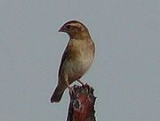
Village Indigobird
Encyclopedia
The Village Indigobird, Vidua chalybeata, is a small songbird
. It is a resident breeding bird in most of Africa
south of the Sahara Desert.
This indigobird
is found in many open habitats including open woodland, scrub and cultivation, but, as its name implies, it is most readily seen near villages.
It is a brood parasite which lays its eggs in the nests of Red-billed Firefinch
es. Unlike the Common Cuckoo
, it does not destroy the host's egg. Typically, 2-4 eggs are added to those already present. The eggs of both the host and the firefinch are white, although the indigobird's are slightly larger. The nestling indigobirds mimic the unique gape
pattern of the fledglings of the host species.
The Village Indigobird is 11-12 cm in length. The adult male is entirely greenish-black except for his orange-red legs and conical white bill. The female resembles a female House Sparrow
, with streaked brown upperparts, buff underparts, a whitish supercilium and a yellowish bill, although she also has red legs. Immature birds are like the female but plainer and without a supercilium.
Many of the indigobirds are very similar in appearance, with the males difficult to separate in the field, and the young and females near impossible. Helpful pointers with the Village Indigobird are the association with its host species, the Red-billed Firefinch, and its presence near human habitation.
The male Village Indigobird is territorial, and he has an elaborate courtship flight display. The song is given from a high perch, and consists of rapid sputtering and churring intermingled with mimicry of Red-billed Firefinch's song, especially the characteristic chick-pea-pea-pea.
The diet of this species consists of seeds and grain.
Songbird
A songbird is a bird belonging to the suborder Passeri of the perching birds . Another name that is sometimes seen as scientific or vernacular name is Oscines, from Latin oscen, "a songbird"...
. It is a resident breeding bird in most of Africa
Africa
Africa is the world's second largest and second most populous continent, after Asia. At about 30.2 million km² including adjacent islands, it covers 6% of the Earth's total surface area and 20.4% of the total land area...
south of the Sahara Desert.
This indigobird
Indigobird
The indigobirds and whydahs, are a family, Viduidae, of small passerine birds native to Africa.These are finch-like species which usually have black or indigo predominating in their plumage...
is found in many open habitats including open woodland, scrub and cultivation, but, as its name implies, it is most readily seen near villages.
It is a brood parasite which lays its eggs in the nests of Red-billed Firefinch
Red-billed Firefinch
The Red-billed Firefinch or Senegal Firefinch is a very small passerine bird. This estrildid finch is a resident breeding bird in almost all parts of sub-Saharan Africa. It has an estimated global extent of occurrence of 10,000,000 km²...
es. Unlike the Common Cuckoo
Common Cuckoo
The Common Cuckoo is a member of the cuckoo order of birds, Cuculiformes, which includes the roadrunners, the anis and the coucals....
, it does not destroy the host's egg. Typically, 2-4 eggs are added to those already present. The eggs of both the host and the firefinch are white, although the indigobird's are slightly larger. The nestling indigobirds mimic the unique gape
Gape
In bird anatomy, the gape is the interior of the open mouth of a bird and the gape flange is the region where the two mandibles join together, at the base of the beak...
pattern of the fledglings of the host species.
The Village Indigobird is 11-12 cm in length. The adult male is entirely greenish-black except for his orange-red legs and conical white bill. The female resembles a female House Sparrow
House Sparrow
The House Sparrow is a bird of the sparrow family Passeridae, found in most parts of the world. One of about 25 species in the genus Passer, the House Sparrow occurs naturally in most of Europe, the Mediterranean region, and much of Asia...
, with streaked brown upperparts, buff underparts, a whitish supercilium and a yellowish bill, although she also has red legs. Immature birds are like the female but plainer and without a supercilium.
Many of the indigobirds are very similar in appearance, with the males difficult to separate in the field, and the young and females near impossible. Helpful pointers with the Village Indigobird are the association with its host species, the Red-billed Firefinch, and its presence near human habitation.
The male Village Indigobird is territorial, and he has an elaborate courtship flight display. The song is given from a high perch, and consists of rapid sputtering and churring intermingled with mimicry of Red-billed Firefinch's song, especially the characteristic chick-pea-pea-pea.
The diet of this species consists of seeds and grain.
Origin
Origin and phylogeny has been obtained by Antonio Arnaiz-Villena et al. Estrildinae may have originated in India and dispersed thereafter (towards Africa and Pacific Ocean habitats).External links
- Village Indigobird videos, photos & sounds on the Internet Bird Collection

